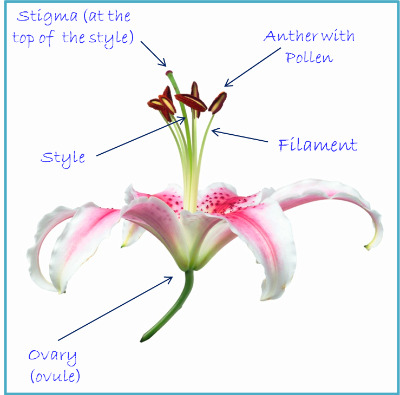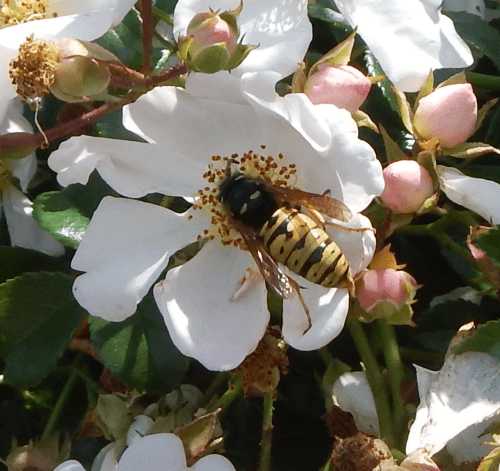Buzz Pollination
What is buzz pollination? Which bees can buzz pollinate and how do bees do it?
Here, we'll take a look at this question, using what we know so far thanks to scientific research. I recommend watching the video of a bumble bee clearly engaging in buzz pollination.
Buzz Pollination: What Is It And Why Do Bees Do It?
Bees need pollen for feeding larvae and to acquire protein and other nutrients, but not all flowers give up their pollen so easily.
In order to collect the pollen from such flowers, some bee species have evolved ways to release it by vibrating the anthers of the flower. As the pollen is freed from the anthers, bees are able to collect the pollen grains on their fur.
Furthermore, as pollen grains are carried from one flower to another, this allows pollination to occur.
 Bumble bees are known to buzz pollinate poppy flowers
Bumble bees are known to buzz pollinate poppy flowersWhy is this called 'buzz pollination'?
The above described process of pollination, is accompanied by a loud buzzing sound as the bee uses vibration to detach the pollen from the flower anthers.
This method of releasing the pollen from the flower anthers is also known as 'sonification' or 'floral sonification'1.
In addition, it is also sometimes called "Vibratile” or “vibrational pollination”2.
Note the following technical definition:
"Sonication is the act of applying sound energy to agitate particles in a sample for various purposes such as the extraction of multiple compounds from plants, microalgae and seaweeds"3.
(Sound comes from vibrations)
How do bees buzz pollinate?
When a bee lands on a flower requiring sonification, she grabs the pollen-bearing anthers by curving the underside of her body around them. She then grasps the base of the flower anthers with her mandibles (jaws)4.
The muscles in the thorax (upper body) are then contracted very fast, hence producing a vibration and a buzzing sound, whilst the wings themselves are prevented from beating (hence preventing flight)4.
The resulting 'buzzing vibrations' are transmitted through the body of the bee to the anthers of the flower. The vibrations cause pollen grains to be expelled. The pollen lands on the bee's electrically charged "sticky hair", where it can be groomed and collected using the legs.
The pollen can then immediately be flown back to the nest, or the bee may continue foraging, hence simultaneously carrying tiny pollen grains on her hair to the stigma of another flower, enabling pollination (fertilization) to take place4.
Watch this short video of a bumble bee using sonification to release pollen from the anthers of a rose flower. Note how she lands on the anthers then grabs them, and the pitch of the buzzing sound as she vibrates against the anthers.
Which bees can buzz pollinate?
More than half of all bee species can buzz pollinate8.
Bumble bees (but not cuckoo species); large carpenter bees and leafcutters can buzz pollinate flowers and food crops.
It has also been confirmed that species of flower bee; various species of sweat bees; squash and plasterer bees; as well as digger bees engage in buzz pollination6.
For more detail, take a look at the list of bees on my page: which bees buzz pollinate?
Which bees do not buzz pollinate?
Not all species engage in sonification. For example, despite being very useful pollinators of many crops, such as almonds, honey bees do not buzz pollinate1. Likewise, I am not aware of any data confirming the use of sonification by mason bees, despite them being helpful pollinators of fruit trees.
Other species that do not specifically buzz pollinate are those which do not collect pollen, including:
- cuckoos (such as cuckoo bumble bees)
- cleptoparasites
- male of all species.
It should be noted that bees unable to buzz pollinate can nevertheless be excellent pollinators. For example, male blue orchard mason bees collect nectar but may still inadvertently transfer pollen from the flowers of one cherry tree to another on their body hairs, thus enabling pollination9.
Which plants and food crops require buzz pollination and why?
Generally, flowers for which buzz pollination is essential are pollen only flowers, offering abundant pollen but no nectar to foraging females6.
Approximately 15,000–20,000 species of plants possess flowers that release pollen only through small openings (pores or slits) in the anther’s tips, and require buzz pollination4.
Examples include Cistus (rockrose), Papaver (poppies), Pedicularis (lousewort), Myrtaceae (myrtles), and Solanum (eg. paradise flower, night shade)4.
A number of important food crops require buzz pollination too, including tomato and egg plant8.
See a list and further information and bees, crops and buzz pollination.
References
1. King, Marcus J., and Stephen L. Buchmann. “Floral Sonication by Bees: Mesosomal Vibration by Bombus and Xylocopa, but Not Apis (Hymenoptera: Apidae), Ejects Pollen from Poricidal Anthers.” Journal of the Kansas Entomological Society, vol. 76, no. 2, 2003, pp. 295–305, http://www.jstor.org/stable/25086116.
2. Stephen L. Buchmann, James P. Hurley, A biophysical model for buzz pollination in angiosperms, Journal of Theoretical Biology, Volume 72, Issue 4, 1978, Pages 639-657, ISSN 0022-5193, https://doi.org/10.1016/0022-5193(78)90277-1.
3. Garcia-Vaquero, M.; Rajauria, G.; O'Doherty, J.V.; Sweeney, T. (2017-09-01). "Polysaccharides from macroalgae: Recent advances, innovative technologies and challenges in extraction and purification". Food Research International. 99 (Pt 3): 1011–1020. doi:10.1016/j.foodres.2016.11.016. hdl:10197/8191. ISSN 0963-9969. PMID 28865611.
4. De Luca PA, Vallejo-Marı´n M. What’s the ‘buzz’ about? The ecology and evolutionary significance of buzz-pollination, Curr Opin Plant Biol (2013), http:// dx.doi.org/10.1016/j.pbi.2013.05.002
5. Tayal, M.; Kariyat, R. Examining the Role of Buzzing Time and Acoustics on Pollen Extraction of Solanum elaeagnifolium. Plants 2021, 10, 2592. https://doi.org/10.3390/ plants10122592
6. Buchmann, Stephen L. “Bees Use Vibration to Aid Pollen Collection from Non-Poricidal Flowers.” Journal of the Kansas Entomological Society, vol. 58, no. 3, 1985, pp. 517–25, http://www.jstor.org/stable/25084671.
7. Carolyn E. B. Proenca. “Buzz Pollination - Older and More Widespread Than We Think?” Journal of Tropical Ecology, vol. 8, no. 1, 1992, pp. 115–20, http://www.jstor.org/stable/2559819.
8. Hazel Cooley, Mario Vallejo-Marín, Buzz-Pollinated Crops: A Global Review and Meta-analysis of the Effects of Supplemental Bee Pollination in Tomato, Journal of Economic Entomology, Volume 114, Issue 2, April 2021, Pages 505–519, https://doi.org/10.1093/jee/toab009.
9. Bosch J, Kemp WP. 2001. How to manage the blue orchard bee. Sustainable Agricultural Network, Beltsville Maryland.


